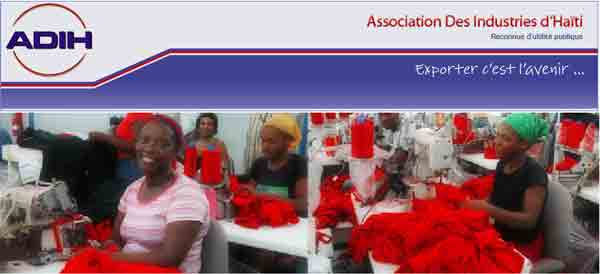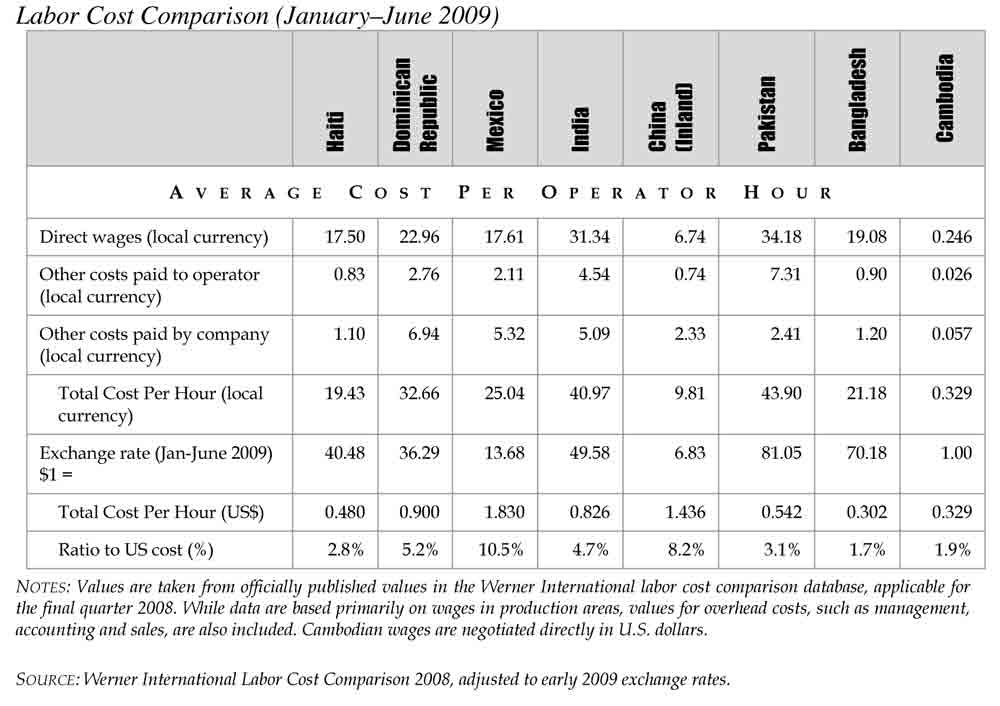Why is Haiti “attractive”?
3rd of 7 articles
Last September, President Michel “Sweet Micky” Martelly told foreign investors that Haiti is ready for “new ideas and new businesses.” The country, he said, is “creating the conditions necessary for Haiti to become a natural and attractive destination for foreign investment.”
But the ideas are not that new.

Page from the Association of Haitian Industries. The slogan says "Exporting is the future."
Over thirty years ago, the Haitian and US advisors of dictator Jean-Claude Duvalier had almost the same plan for Haiti’s economy. The impoverished country would become the “Taiwan of the Caribbean” – a vast factory complex offering low sweatshop wages where to US industries could assemble working in textiles, electronics and baseballs.
How has it worked out?
Three decades and billions of dollars in investments later, workers in Haiti earn less than they did under “Baby Doc.” [See Salaries in the “new” Haiti - Story #1] And studies like Yasmine Shamsie’s Time for a “High-Road” Approach to EPZ Development in Haiti note that “[w]hile the [Free Trade Zone] model did create jobs, it also had important negative effects on Haiti’s poor.”
Among the “negative effects” the Canadian researcher noted:
- Increase in income concentration and regional inequality
- A rise in food and housing prices
- Slums in marginal areas sprang up, in part because of the rural exodus spurred by the factories, but also because “wages were too low to provide workers with decent or safe accommodations.”
Those results haven’t stopped Haitian politicians and “development experts” from doing “déjà vu all over again” planning. This time, however, plans call for “decentralizing” the factories.
In 2002, President Jean Bertrand Aristide kicked off the new round when he and Parliament passed sweeping “Investment Code” and “Free Trade Zone” legislations. The new laws offer 15-year tax holidays, duty-free import and export, and tax-free repatriation of profits. Only one Free Trade Zone (FTZ) opened last decade – CODEVI on the Haitian-Dominican border – but others were in the works prior to the January 12, 2010, earthquake, thanks to the incentives offered by duty-free textile trade agreements with the US.

President Jean-Bertrand Aristide (L) breaking ground for the CODEVI
industrial park in 2003. Photo: Daniel Morel
In fact, the changes in the international garment industry during the last decade – due to the 2005 expiration of the Multi-Fibre Arrangement (MFA) and the Agreement on Textiles and Clothing which gave developing countries low-duty or duty-free export quotas for the US, Europe and other “developed” countries – have created havoc.
When those agreements ended, thousands of factories in low-wage countries around the world shut their doors or laid workers off as international contractors sought out more advantageous locations to have their clothes stitched. Perhaps not uncoincidentally, the very next year, in 2006, US Congress passed the Haitian Hemispheric Opportunity through Partnership Encouragement (HOPE) Act that gave preferential access to Haitian-sewn clothing. Two years later, HOPE II expanded the preferences and locked them in place for ten years.
Then, in the wake of the earthquake, Congress approved the Haiti Economic Lift Program (HELP) Act, which nearly triples duty-free quotas for clothing exports from Haiti to the US and stretches the access up through 2020.
But the names “HOPE” and “HELP” shouldn’t mislead readers into thinking the legislation is meant to be “hopeful” or “helpful” to Haitian factory owners or workers only.
Writing for the United Nations in 2009, economist Paul Collier noted that “[u]niquely in the world Haiti has duty-free, quota-free access to the American market guaranteed.”
“Haiti has a massive economic opportunity in the form of HOPE II,” Collier wrote in his Haiti: From Natural Catastrophe to Economic Security report for UN General Secretary Ban Ki-moon.
“The global recession and the failure of the [World Trade Organization] Doha Round accentuate this remarkable advantage because manufacturers based in other locations will undoubtedly be fearful that rising protectionist pressures may threaten whatever market access they enjoy currently. From the important perspective of market access Haiti is now the world’s safest production location for garments.” [author’s italics]
Collier and the other cheerleaders say Haiti won’t be able to sell its “unique” advantage unless it carefully assures a few sine qua nons.
Low wages Wages must be kept low. A World Bank/Inter-American Development Bank report prepared for the 2011 Davos World Economic Forum noted that, at the moment, Haiti’s labor costs were “fully competitive with China’s,” while wages in the Dominican Republic are “high,” which has led to a “decline” in the assembly industry there. [See also Anti-union, pro-“race to the bottom” - Story #2]
What are the wages across the border?
In 2009, minimum wage for Free Trade Zone workers was US$35 a week, which, according to the US State Department – cited in a study by Georgetown Professor John M. Kline – “did not provide a decent standard of living in any industry for a worker and family,” according to
The implication? Haitian sweatshop wages won’t be going up any time soon. They currently stand at about $35 a week…
24/7 production – The clothing industry “operates multi-shift production,” Collier noted in his report, where he called for Haitian factories to include night shifts. The Haitian private sector agrees. In its post-earthquake Vision and Roadmap for Haiti report, Haiti’s industrialists and business owners called for “flexible labor laws, including immediately legalizing the 3x8 work shift to allow increased competitiveness in the garment industry.”
Public investment – Not surprisingly, Haiti’s would-be sweatshop investors are also looking for subsidies and handouts. “Given the risk and timing associated with garment tenants, public funding is necessary to catalyze investment in the new economic development zones,” the Vision and Roadmap noted.
(The factory owners got their wish – the US and other donors are donating almost $200 million to the new Regional Industrial Park of the North (Parc Industriel du Region Nord - PIRN) project. See below and The Case of Caracol - Story #6)
Land for FTZs - “Ensure that land is rapidly available for acquisition in Export Zones,” Collier recommended.

Wage comparison chart, from the government-commissioned
study, Bringing HOPE to Haiti's Apparel Sector.
All of these elements will make sure that Haiti is, as Martelly called it, “a natural and attractive destination.”
What’s planned for Haiti?

